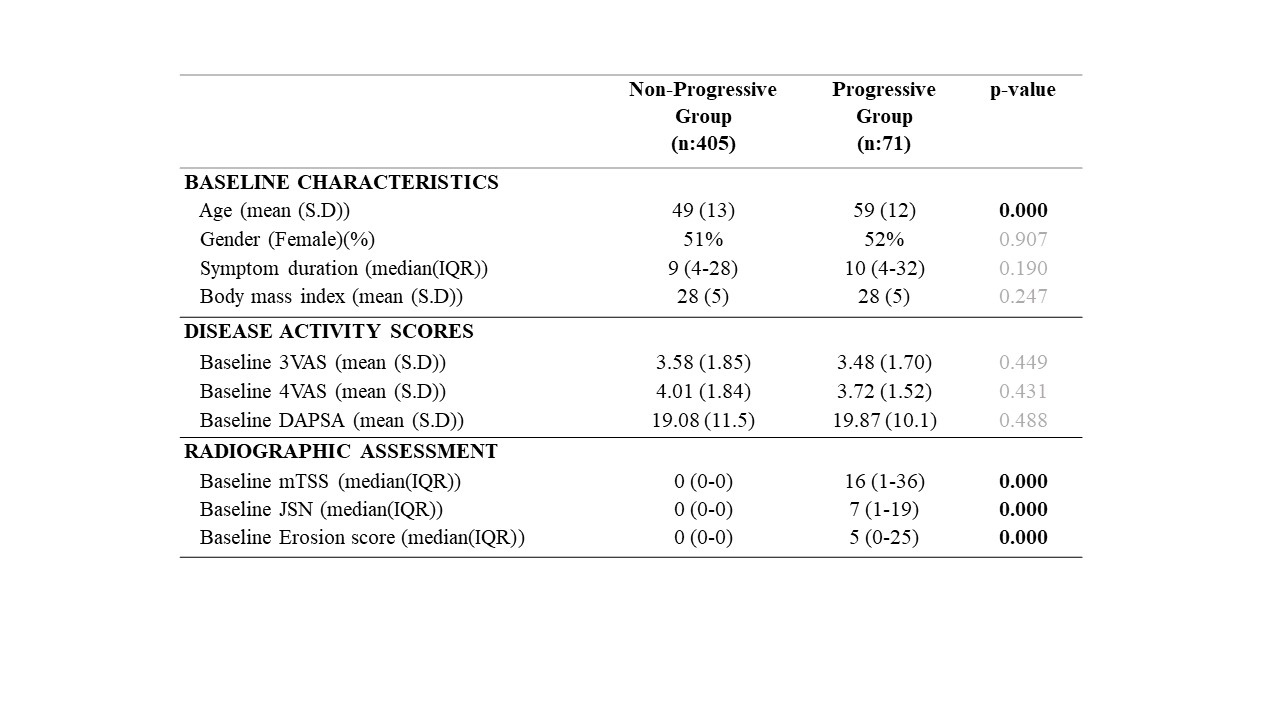Session Information
Session Type: Poster Session B
Session Time: 9:00AM-11:00AM
Background/Purpose: A feasible, widely accepted, comprehensive disease activity measure is needed for daily use in psoriatic arthritis (PsA). Current measures are either complex (Psoriatic Arthritis Disease Activity Score (PASDAS) and strict (Minimal Disease Activity ((MDA)) for use in daily practice or only joint-oriented (DAPSA). To address this, the 3-item VAS (3VAS) and 4-item VAS (4VAS) were developed. This study investigates the association between 3VAS/4VAS and radiographic progression in early PsA patients. Our aim is to evaluate 3VAS/4VAS having association in terms of radiographic progression over 3 years in early PsA.
Methods: Data were from the DEPAR study which consists of newly diagnosed PsA patients. Radiographic changes were graded with the modified Total Sharp Score (mTSS) for PsA chronologically by two independent assessors. The radiographic progression was defined as a change in mTSS >0.7 (SDC) at any time in 3 years of follow-up. The 3VAS consists of a physician’s global VAS, the patient global VAS, and the patient skin VAS. The 4VAS has comprised of a physician global VAS, patient pain VAS, patient joint VAS, and patient skin VAS. Reaching low disease activity (LDA) at 6 months was determined as 3VAS(< 2.4), 4VAS(< 2.8), and DAPSA (≤14). Comparisons between groups were made by Student’s t-test, chi-squared test, or ANOVA. The generalized linear model (GLM) and the Generalized Linear Mix Model (GLMM with a subtype of negative binomial regression analysis) were adjusted for baseline determinants(age, gender, time (visit time), mTSS, CRP, and biological use at any time point).
Results: In comparing the two groups, a total of 476 patients were included, with 71 patients in the progressive group and 405 patients in the non-progressive group (Table 1). During the first 2-year period, the non-progressive and progressive groups showed similar patterns in terms of disease activity scores. However, in the 2nd year, there was a notable change: the progressive group surpassed the non-progressive group in terms of 3VAS, 4VAS, and DAPSA levels (at 3rd year non-prog. vs prog. (mean(S.D.)); 3VAS: 1.75(1.62) vs 2.17(1.64), 4VAS: 2.03(1.76) vs 2.40(2.00), DAPSA: 7.58(5.88) vs 10.4(9.30)) (Figure 2).
Even though patients who achieved LDA according to 3VAS, 4VAS, and DAPSA at 6 months had fewer radiographic changes in 3 years, there were no found significant differences (Figure 1).
For longitudinal analysis, 1.758 mTS scores were included from 4 different time points. The generalized linear mixed-effects model showed that there was no significant association between 3VAS/4VAS or DAPSA levels and radiographic changes over time (Figure 2).
Conclusion: No significant association was observed between the 3VAS and 4VAS measures and radiographic damage in our longitudinal real-world cohort of early PsA patients. This lack of association is likely attributed to the relatively low radiographic progression observed in this cohort rather than being solely influenced by the measures themselves. Furthermore, the articular-oriented measure DAPSA also exhibited no significant association with radiographic damage in early PsA patients.
To cite this abstract in AMA style:
Koc G, Kok M, Luime J, Tchetverikov i, Tillett W, Kasiem F, Korswagen L, Bijsterbosch J, Goekoop-Ruiterman Y, van oosterhout M, Baudoin P, Kok P, Dolhain r, vis m. The Association of 3VAS/4VAS and DAPSA with Radiographic Progression in Early PsA [abstract]. Arthritis Rheumatol. 2023; 75 (suppl 9). https://acrabstracts.org/abstract/the-association-of-3vas-4vas-and-dapsa-with-radiographic-progression-in-early-psa/. Accessed .« Back to ACR Convergence 2023
ACR Meeting Abstracts - https://acrabstracts.org/abstract/the-association-of-3vas-4vas-and-dapsa-with-radiographic-progression-in-early-psa/



